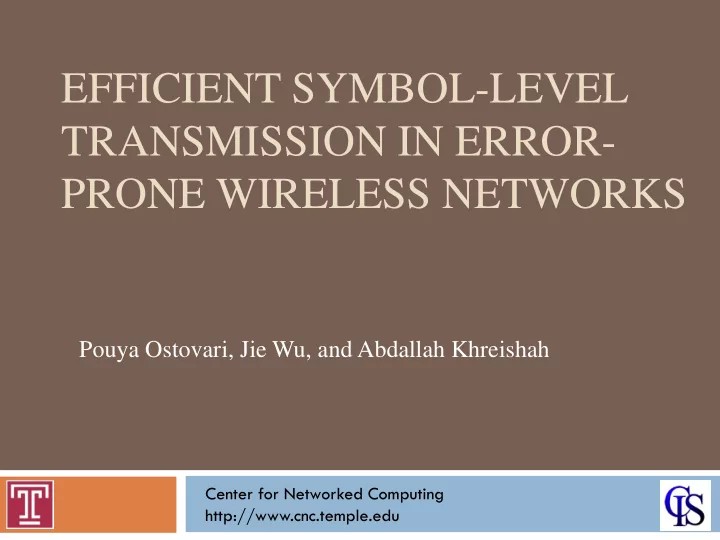

EFFICIENT SYMBOL-LEVEL TRANSMISSION IN ERROR- PRONE WIRELESS NETWORKS Pouya Ostovari, Jie Wu, and Abdallah Khreishah Center for Networked Computing http://www.cnc.temple.edu
Agenda 2 Introduction Motivation Setting Proposed methods Single packet Multiple packets Multiple packets with network coding Simulation results Conclusion
Introduction 3 Broadcasting in wireless networks Disseminating data and control messages Error-prone wireless links Provide reliability ARQ Hybrid-ARQ Erasure codes Fountain codes (rateless codes)
Introduction 4 Errors in packets Not binary Numeric data Like sensed data by sensor nodes The important of the symbols (bits) are different The importance of the symbols should be considered Choices Reliable transmissions Maximizing the expected gain with a fixed given number transmissions
Motivation 5 2 transmissions 3 transmissions
Setting and Objective 6 One-hop network Lossy links Transmission window size t slots for a packet Objective: maximizing the total weight of the received symbols
Single Packet (One Destination) 7 The case of a packet size equal to 2 symbols Saturation point
Single Packet (One Destination) 8 We consider the problem in rounds of transmissions The first time we should increment is when After the saturation point, the distribution of the transmissions has a round-robin incrementing pattern The proof of optimality is provided in the paper
Single Packet (One Destination) 9 Generalizing to m symbols We assign the transmissions to until Then, we distribute the remaining transmissions between and until After this point, we continue the round-robin pattern among and In general, we start incrementing when: The proof of optimality: in the paper
Single Packet (Multiple Destinations) 10 In the case of different transmission error rates, the round-robin pattern does not exist Iterative algorithm We assign the transmissions to the symbols in t rounds At each iteration we assign the current transmission to the symbol with maximum
Multiple Packets 11 Our model The size of the packets are equal The weights of the i -th symbols in different packets are the same The problem of sending k independent packets becomes k similar problems with the same solution We can solve the problem for a single packet, and repeat it for any packet
Multiple Packets- with Network Coding 12 We first find the optimal We code all of the i -th symbols of the k packets together Instead of sending the i -th symbols of each packet times, we send coded symbols
Multiple Packets- with Network Coding 13 Using network coding might increase or decrease the gain Since partial decoding is not possible For each set of the i -th symbols we compare the gain of coding and non-coding We turn off coding if it decreases the gain
Simulations Setting 14 MATLAB environment 1,000 random topologies Different links’ error rates Weight of the i-th symbol: Compare with simple retransmission method Distribute the transmissions evenly to the different symbols of the packets
Simulations- (Single Destination) 15 • Single packet- 10 symbols
Simulations- (Multiple Destinations) 16 • Single packet- 10 symbols • 10 transmissions
Simulations 17 • Packet size: 5 symbols 10 transmissions 50 packets
Simulations 18 • Packet size: 5 symbols • 5 destinations
Simulations Summary 19 Our proposed MPT mechanism can increase the gain up to 22% compared to that of a simple retransmission mechanism Our network coding scheme enhances the expected total gain up to 45% compared to the simple retransmission mechanism
Summary 20 There is much work on reliable transmissions over error-prone wireless channels We propose a novel transmission scheme which is based on the importance of the symbols (bits) Proposed methods Single packet Multiple packets Multiple packets with network coding
21 Questions Pouya Ostovari ostovari@temple.edu http://astro.temple.edu/~tuc71330
Recommend
More recommend